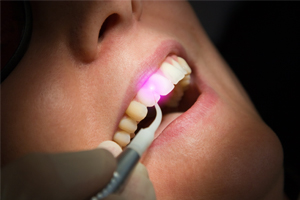
At Casco Bay Smiles we are always striving to provide the highest standard of care for our patients and have now incorporated a diode laser into our office to help us achieve this. It is amazing and lowers the type of bacteria related to gum disease and heart disease. It is a painless procedure and takes about 5 minutes to do! Below are just a few of the ways our hygienists have incorporated lasers in our office to benefit our patients needs.
Laser Bacterial Reduction
Like many people, you might be someone who tends to bleed while plaque and tartar are removed from your teeth. If you experience bleeding during your hygiene appointments then you would benefit from our laser bacterial reduction procedure. During your “cleaning” or continuing care appointment, we are now able to use the laser to kill most of the bacteria and decontaminate your mouth before we even start your appointment. The bacteria count is lowered from billions to just a few hundred. This significantly reduces the amount of bacteria that enters the bloodstream, therefore reducing the risk of harmful bacteria potentially filtering through your body afterwards. The reason we offer this high level of prevention is because dental bacteria has long been linked to heart disease, prostate cancer, low birth weight babies, preterm labor, diabetes and many more inflammatory diseases. A recent study even indicated a link between periodontal disease and Alzheimer’s disease. Our laser bacterial reduction procedure has no side effects, is painless and even safe for pregnancy.
Active Laser Therapy
We also use the laser as an adjunct to gum disease treatment or what is commonly referred to as “scaling and root planing”. Laser Therapy helps decontaminate periodontal pockets, decreasing the numbers of periodontal pathogens by removing infected or diseased issue. This stimulates the body’s healing processes. Use the laser as a part of gum disease treatment decreases tissue sensitivity following the appointment, yields faster healing and more successful results.
Biostimulation
We can also use the laser to treat tooth hypersensitivity and certain mouth sores like canker sores and cold sores. This is achieved by a different process known as biostimulation. The laser fiber is held a couple of millimeters away from the lesion or the tooth. By directing the laser energy at the area the patient will start to feel immediate pain relief. Tooth desensitizing can be performed prior to an appointment but will also help reduce discomfort at home for an extended period of time. An ulcer will usually heal overnight and dramatically accelerate the wound healing and anti-inflammatory effects in the tissue.
At Casco Bay Smiles we are excited to be able to provide cutting edge care for our patients. Please contact us for more information on our laser treatments.
- Jacqueline Detert, Nicole Pischon, Gerd R Burmester and Frank Buttgereit. “The association between rheumatoid arthritis and periodontal disease.”Arthritis Research & Therapy. Dec 2010;218:1-7.
- Sophie Poole, Sim K Singhrao and St John Crean. “Emerging evidence for associations between periodontitis and the development of Alzheimer’s disease.” Dental Journal. Jan 2014;5(1): 40-42.
- Karim El Kholy, Robert J.Genco, Thomas E.Van Dyke. “Oral infections and cardiovascular disease.” Trends in Endocrinology and Metabolism. June 2015; 26(6): 315-321.
- Polansky R, Haas M, Heschl A, Wimmer G. “Clinical Effectiveness of Photodynamic Therapy in the Treatment of Periodontitis.” J. Clin Periodontol. June 2009; 36: 575-580.
- Gregg R, McCarthy D. “Eight Year Retrospective Review of Laser Periodontal Therapy in Private Practice.” Dentistry Today. Feb. 2003; 22(2): 1-4.
- Angelov N, Pesevska S, Nakova M, Gjorgoskil I, Ivanovski K, Angelova D, Hoffman O, Andreana S. “Periodontal Treatment with a Low-Level Diode Laser: Clinical Findings.” General Dentistry. Sept/Oct 2009: 510-513.
- Coleton S. “The Use of Lasers in Periodontal Therapy.” General Dentistry. Nov/Dec 2008: 612-616.
- Yuichi Kimura, Petra Wilder‐Smith, Kazuo Yonaga, Koukichi Matsumoto. “Treatment of dentine hypersensitivity by lasers: a review.”Journal of Clinical Periodontology. Dec 2001; 27(10) 715-721.
